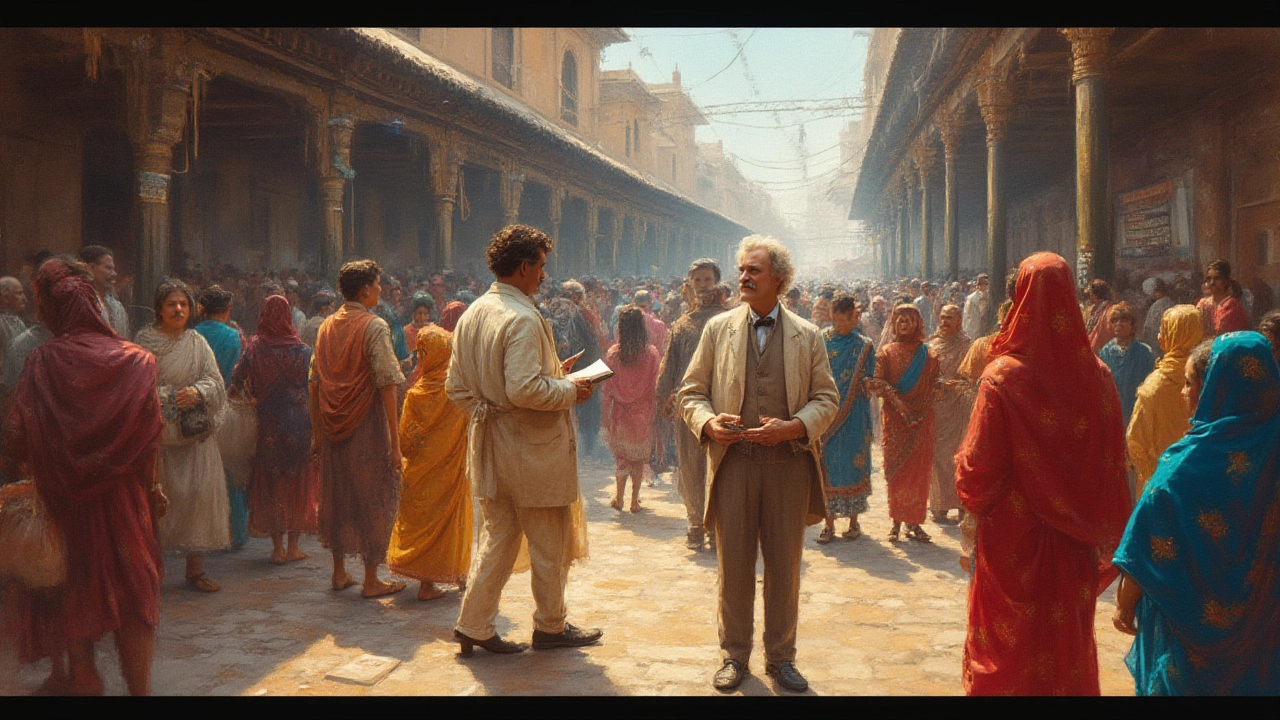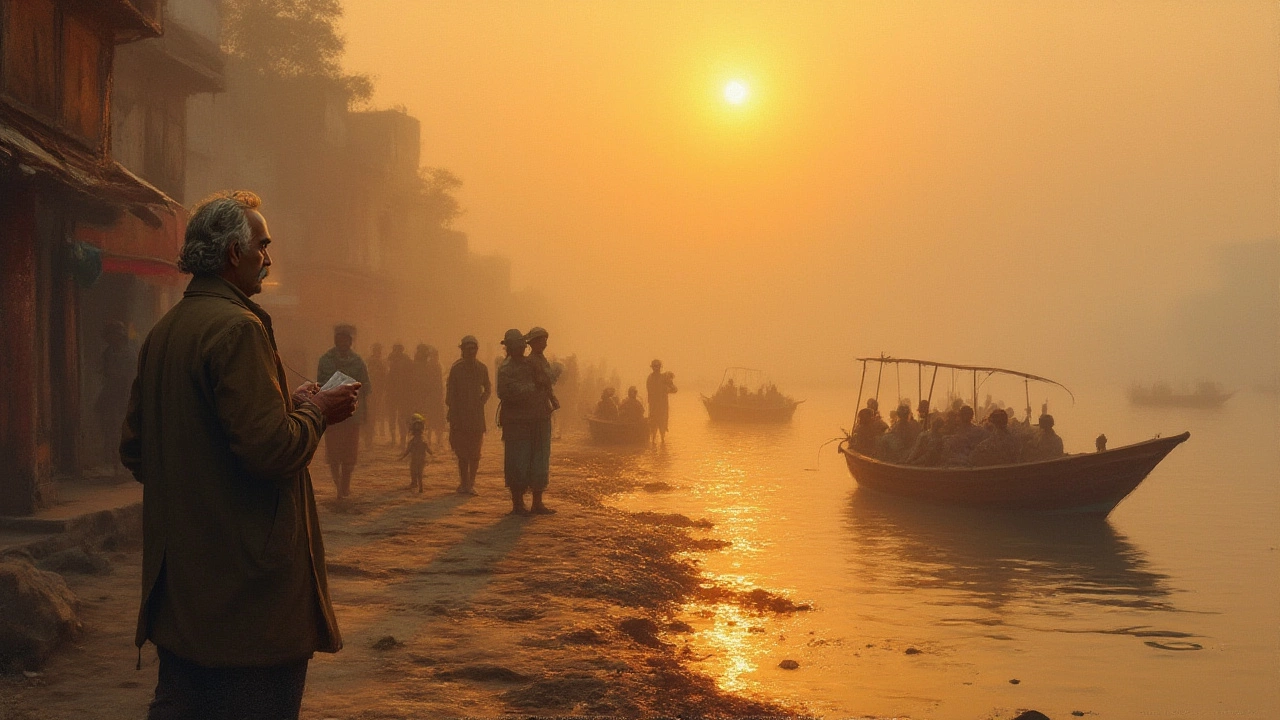Mark Twain’s Writings on India: Insights, Stories, and Real Impressions

Here’s something wild—Mark Twain, the snarky American who gave us Tom Sawyer and Huck Finn, once spent months wandering across India. Yeah, imagine that dusty mustache making its way through the chaos of Bombay (now Mumbai), riding elephants to ancient palaces, and tossing out one-liners about the Ganges. If you dig around in the footnotes of history, you’ll find Twain wasn’t just sightseeing—he was poking fun, getting surprised, sometimes being flat wrong, and sometimes nailing things you’d still recognize today if you walked the streets of Varanasi.
Mark Twain’s India Adventure: What REALLY Happened?
Mark Twain visited India in 1896 while on his world lecture tour, and it wasn’t exactly a luxury posting. Twain was broke after making some bad investments (ok, let’s call it going bust from a fancy printing machine that flopped), so he hit the road to make money. This trip, which became the backbone of his book Following the Equator, turned out to be one of his most eye-opening journeys—and left him way different from the Samuel Clemens who started it.
Twain stepped off the boat in Bombay and jotted down his first impressions. He was overwhelmed by the crowds, complexity, and energy. According to his notes, there was “always something going on” and, “a relentless, tireless, searching curiosity in everyone’s eyes.” He compared the streets’ bustle to a river during flood season—impossible to tame, unpredictable, and absolutely fascinating.
He didn’t stay put, either. Twain traveled by train, boat, and occasionally atop animals—moving all the way from Bombay to Calcutta, with detours in Agra, Benares (now Varanasi), Allahabad, and other key cities. He visited the Taj Mahal, explored the sacred Ganges, and mingled with holy men. Everywhere he went, he tried to sketch not just what he saw, but the odd ways those places mixed the ancient with the brand-new. The stuff he noticed? Not what tourists rush to take selfies with today.
The currency at the time? India’s rupee, of course. Here’s a quick snapshot of currencies Twain would’ve dealt with then—just to get concrete:
| Type | Name | Equivalent Value (then) |
|---|---|---|
| Coin | Rupee | About 1/16 Pound Sterling |
| Notes & Silver | Anna/Four Annas | 1/16, 1/4 of a Rupee |
Twain was often both delighted and confused by the jumble of languages, traditions, and ideas. One day he’d be writing sarcastically about British colonial officials, the next, moved by a child’s funeral procession on the riverbank. The big thing: he never pretended he ‘got’ India. If he didn’t understand something, he’d say so—sometimes in ways that made readers laugh or shake their heads. His honesty about confusion, culture shock, and awe might sound more real than anything in the average guidebook.
What Twain Actually Wrote: Stories, Critiques, and Culture Shocks
The heart of Twain’s writings about India show up in Following the Equator. If anyone tells you he wrote a whole book just about India, they’re mixing things up. India fills about a third of the book, with dozens of pages focused just on his travels there. Unlike his novels, these pages are raw—part travel diary, part biting social commentary, part fish-out-of-water comedy.
He talks about meeting fakirs (holy men) who performed “miracles,” observing rituals along the Ganges, touring ruined temples, and trying to wrap his mind around the idea of karma. He also didn’t shy away from the hard stuff. He criticized the way the British treated Indians, pointing out hypocrisy in colonial rule, and the “justice” system that was anything but fair. In Agra, he writes about the Taj Mahal, calling it “a poem in marble” — which still sticks to this day. But then he’ll flip around and focus on monkeys running wild, or street beggars dodging cows in traffic. The difference between reverence and irreverence in Twain’s writing can change in a single sentence.
Here’s a glimpse of what made Twain’s India stories unique:
- He once camped near the Ganges and watched the nightly rituals, describing the scene as “a million fireflies let loose with purpose.”
- In Benares (Varanasi), he marveled at the timelessness—how sacred rituals felt like something out of another millennium, unchanged for thousands of years.
- He poked at religious stereotypes, but also expressed genuine respect. He called the concept of reincarnation “both terrifying and strangely practical” after seeing people’s devotion to rituals.
- He tried to ride an elephant—and ended up joking about how there’s nothing dignified about clinging to “rough gray hide” while sliding sideways.
- He was stunned by India’s contradictions: the density of poverty beside stunning beauty, the kindness shown by strangers, and the endless negotiation over prices, services, and just about everything.
- He found humor literally everywhere. One line: “India is the only country under the sun that the stranger does not outstay his welcome.”
The depth in Twain’s observations stands out. He could make his readers laugh at one line, then hit you in the gut with the next. He pokes at British officials, but is also critical about injustice anywhere he sees it. His American background meant he didn’t side—he watched, pointed out oddities, and tried to stay honest about what he didn’t get. Sometimes, the result was ignorance. Sometimes, fresh insight. But you always get the sense he was paying sharp attention and calling it as he saw it.

Little-Known Facts and Misconceptions: Digging Past the Clichés
Most people assume Mark Twain’s notes about India are all exotic elephants and wild temples. The real dirt? Twain’s interest was way wider and much less filtered. Here are a few surprises:
- A recurring theme is Twain’s preoccupation with time in India. He believed the country felt ageless, with “whole centuries looking calmly on past your hotel window.” Twain got obsessed with how traditions lingered, making India feel both modern and ancient at the same time.
- Twain was a fan of Indian railways. He called them “the arteries and veins” of the new India, writing with awe about the mind-boggling distances ordinary Indians traveled for work, trade, or pilgrimage.
- He admired the way Indian people could find humor and joy even in hard circumstances. He wrote, “the poor in India are not often poor in spirit.”
- Tons of his observations about India’s caste system were way ahead of their time. He didn’t just see it as a weird curiosity—he critiqued it for the way it shaped people’s destinies and daily lives, sometimes referring to it as “a wall thicker than any in Rome.”
- Twain wrote about the British obsession with tea and cricket, but seemed far more enchanted by street food vendors and the rhythm of local bazaars.
One of Twain’s best passages comes from his visit to Benares, where he tried to understand how so many different religions, sects, and philosophies somehow managed to mingle in one city without breaking into open chaos. He joked about “being more lost philosophically than geographically,” but readers could see him grappling with ideas he’d never confronted before.
It’s a real twist that Twain sometimes got things wrong. He misinterpreted customs or mixed up details—probably just a symptom of being in way over his head. But he wasn’t afraid to admit it. These moments didn’t make his writing weaker; they made it funnier, humbler, and strangely relatable. “I am not equipped to judge the mysteries of India,” he confided, “but I hope to report accurately the flavor of being confused.” Not a lot of travelers admit that these days, and it gives his writing a raw honesty.
Should You Read Twain on India Today? Takeaways, Warnings, Tips
If you’re thinking about picking up Following the Equator to read Twain’s India stories, you’ll get a wild mix. Some parts feel dated, with language or ideas that show their age. But the sharpness, curiosity, and ability to laugh at himself are still contagious. You might not agree with every take, and you’ll definitely roll your eyes now and then. But Twain’s honesty makes the book a go-to for anyone drawn to weird travel stories, culture clashes, or the way history looks when filtered through an outsider’s eyes.
Here’s a cheat sheet if you decide to read Twain on India:
- Watch for how often Twain focuses on everyday life—not big tourist sites. He spends more print on railway stations, funeral processions, and street markets than on palaces.
- His sarcasm isn’t mean for the sake of being mean. A lot of it is directed at colonial attitudes, useless bureaucracy, or his own confusion. Missing the joke? Check the end of the paragraph again—he often sets up with straight talk and lands the punchline unexpectedly.
- Don’t trust him for absolute accuracy. He gets things muddled or mixes up Indian words. If you want to fact-check, ideal! But the flavor of the era—what it must have felt like to be there—is real.
- Twain’s big point: India is “the land of wonders,” but not in the way snap-happy travelers mean. For him, the wonder lay in the clash of ancient and modern, the messy and the beautiful living side-by-side, and the ways strangers could find common ground despite massive gaps.
- Modern travelers sometimes walk the same routes Twain did, comparing his notes with what they see in India today. You’ll find old hotels Twain stayed at still standing, river ghats humming with rituals unchanged in more than a century, but cities way more crowded and tech-savvy. It’s a wild time-travel game.
If you want a conversation starter at a dinner party, drop this fact: Mark Twain called India “the land of wonders,” but finished his trip still scratching his head—and loving it. That sense of awe, and the willingness to be amazed, is something even today’s travelers can learn from. Sometimes, it’s not about understanding everything. Sometimes, it’s about letting yourself get lost for a while and trusting the story to surprise you.